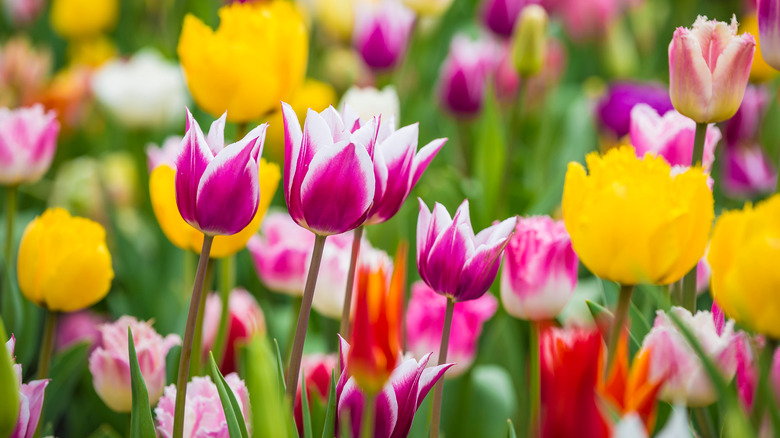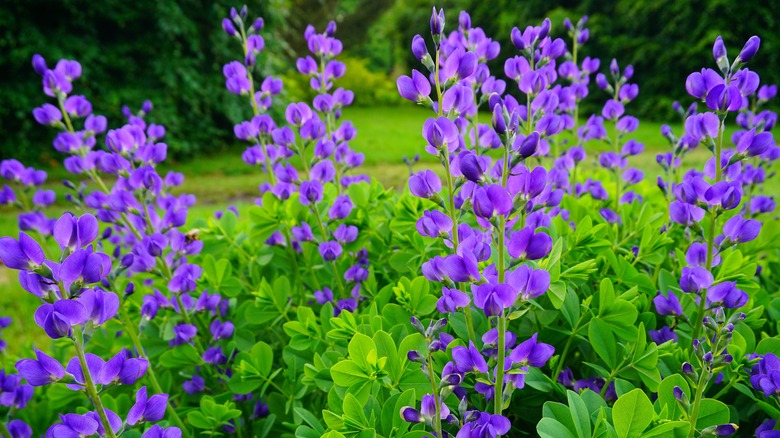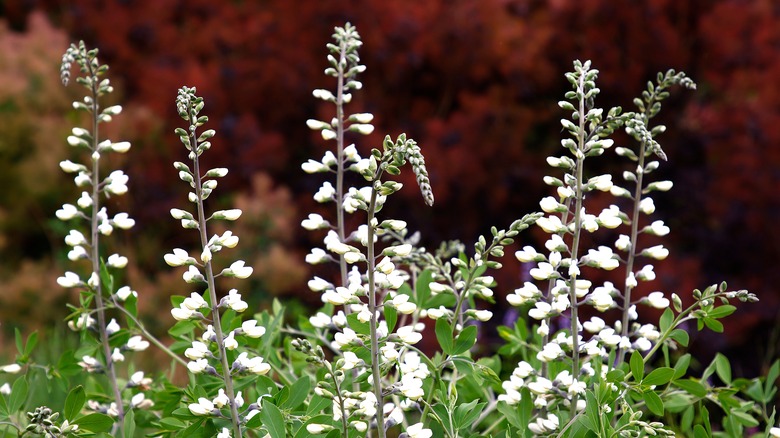The Tall Flowering Plant That Makes A Stunning Backdrop For Garden Bulbs
Spring-blooming bulbs are a stunning addition to almost any garden, with crocuses and snowdrops providing color and life when little else is flowering yet. Once those bulbs have blossomed, letting their leaves die back naturally is important, a process that many people find unsightly. Luckily, baptisia, a beautiful perennial, can camouflage the dying foliage of early spring bulbs and provide a vibrant backdrop to later blooming bulbs like alliums and late tulips.
Baptisia works so well with spring bulbs, in part because of its growth cycle. It is an herbaceous perennial that dies back to its roots each winter, just to return each spring, ready to flower sometime between March and May or June, depending on the region. All species in the Baptisia genus are native to the Eastern and Central United States, and while different species have slightly different ranges, many, including the yellow Baptisia tinctoria and the blue Baptisia australis, which is sometimes known as false indigo, grow well in zones 3 through 9.
Caring for baptisia in the garden
Baptisia can be either started from seed or purchased as a young plant, depending on the specific species and cultivar. Regardless of how you start your baptisia, don't be disappointed if it, like many perennials, takes three years to mature and begin flowering. Be patient, and as long as you plant your baptisia in a full sun or part shade location and remember to give it plenty of water until it is fully established, it should thrive in no time.
Thanks to its brittle and deep roots, baptisia has a well-deserved reputation for being difficult to transplant or dig up. So don't plant it until you're confident you have a perfect location where it will have plenty of space to thrive and grow for years. Once it is mature, baptisia is quite drought tolerant. Because it is in the legume family, it can create its own usable nitrogen thanks to a symbiotic relationship with the rhizobia bacteria. This means that baptisia requires little fertilizing itself and may even improve the area for plants around it, adding nitrogen to your soil and giving you a healthier garden in no time.
Pairing bulbs and baptisia
Most bulbs require well-draining soil and full sun to perennialize, similar to baptisia, which requires at least part sun and can handle a variety of soil conditions. As most species of baptisia grow to around 4 feet tall and wide, they are taller than most bulbs and should be planted in the back of gardens with your shorter bulbs located in the front. Giant alliums (Allium giganteum), which can grow to 6 feet, are an exception and may work best interspersed between baptisia plants, allowing both to shine. Don't forget to plan ahead since spring-blooming bulbs are planted in fall.
As baptisia breaks dormancy and grows, it distracts from the dying foliage of your earliest blooming bulbs like snowdrops and crocuses. It provides a leafy green backdrop for your midseason daffodils and fritillaria. By the time those have faded and their foliage begins to yellow, the baptisia should be starting to flower, providing a dramatic show that will command full attention. Choose colors of alliums and late-blooming tulips that pair with the flowers of your baptisia, as they will likely bloom together. Whether you opt to grow Baptisia alba, which boasts pure white flowers that will show off riotous rainbows of parrot and fringed tulips, or go with the purplish blue flowers of Baptisia australis which are an almost perfect match for the violet heads of ornamental alliums, these late spring bulbs and baptisia should pair perfectly.


